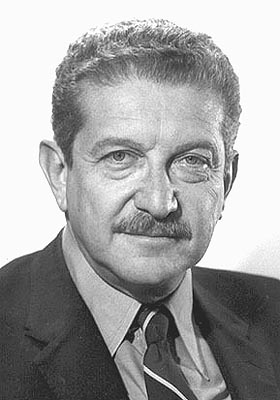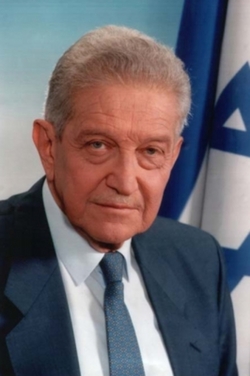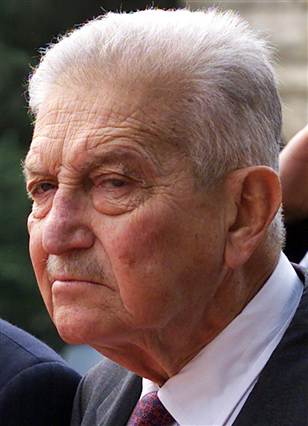<Back to Index>
- Deputy Chief of the General Staff and 7th President of Israel Ezer Weizman, 1924
PAGE SPONSOR



Ezer Weizman (Hebrew: עזר ויצמן, 15 June 1924 - 24 April 2005) was the seventh President of Israel, first elected in 1993 and re-elected in 1998. Before the presidency, Weizman was commander of the Israeli Air Force and Minister of Defense.
Weizman was born in Tel Aviv as Ezer Weizmann on 15 June 1924. His father, Yechiel, was an agronomist. He grew up in Haifa, and attended the Hebrew Reali School.
He married Reuma Schwartz, sister of Ruth Dayan, wife of Moshe Dayan, and they had two children, Shaul and Michal. Weizman was a nephew of Israel's first president, Chaim Weizmann. He died of respiratory failure at his home in Caesarea on 24 April 2005, at the age of 80. He is not buried on Mt. Herzl, where Israeli presidents and prime ministers are usually interred, but alongside his son and daughter - in - law in Or Akiva.
Weizman was a combat pilot. He received his training in the British Army in which he enlisted in 1942 in order to fight the Nazis. He served as a truck driver in the Western Desert campaigns in Egypt and Libya. In 1943, he joined the British Royal Air Force (RAF) and attended aviation school in Rhodesia. He served with the RAF in India in early 1944. Weizman ended his service in the RAF as a sergeant pilot.
Between 1944 and 1946, he was a member of the Irgun underground in Mandatory Palestine. Between 1946 and 1947, he studied aeronautics in England.
Weizman was a pilot for the Haganah in the 1948 Arab - Israeli War. He was the commander of the Negev Air Squadron near Nir-Am. In May 1948, he learned to fly the Avia S-199 at the České Budějovice air base in Czechoslovakia and participated in Israel's first fighter mission, a ground attack on an Egyptian column advancing toward Ad Halom near the Arab town of Isdud south of Tel Aviv. In a battle between Israeli and British RAF aircraft on 7 January 1949, he flew one of four Israeli Spitfire fighters that attacked 19 British fighters, which were on a rescue mission in Egypt searching for four aircraft that had been destroyed in an earlier IAF attack. An RAF Hawker Tempest was shot down by the IAF, resulting in the death of the pilot. Due to a failure by ground crewmen, most of the RAF aircraft were not armed.
After the establishment of the State of Israel, Weizman joined the Israel Defense Forces and served as the Chief of Operations on the General Staff. In 1951 he attended the RAF Staff College, Andover in England. Upon his return he became commander of Ramat David.
He served as the commander of the Israeli Air Force between 1958 to 1966, and later served as deputy Chief of the General Staff. He directed the early morning surprise air attacks against the Egyptian air bases, which resulted in giving the Israelis total air superiority over the Sinai battlefields by totally destroying the Egyptian Air Force in 3 hours. A total of 400 enemy planes were destroyed by the Israeli Air Force on the 1st day of the Six Day War.
Although he became the IDF's Deputy Chief of Staff in 1966, he retired from military service in 1969.
Upon retiring from the military, Weizman joined the right wing Gahal party. He served as Minister of Transportation in Levi Eshkol's national unity government until Gahal left the coalition in 1970. Weizman quit Gahal in 1972, but returned in 1976, by which time it had become Likud. In 1977, he became Defense Minister under Menachem Begin. During his term, Israel launched the Litani Operation against the PLO in south Lebanon and developed the IAI Lavi fighter.
Over time, Weizman's views became more dovish. After the visit to Jerusalem of Egypt's president Anwar Sadat in 1977, Weizman developed a close friendship with him. These relations were a crucial factor in the talks that culminated in the 1978 Camp David accords, followed by a peace treaty with Egypt the following year.
In May 1980, Weizman quit the government. He considered establishing a new party with Moshe Dayan, which led to his ousting from Likud. For the next four years, he put politics on hold and entered the business world.
In 1984, he established a new party, Yahad, which won 3 seats in the 1984 elections. The party joined a national unity government in which Shimon Peres and Yitzhak Shamir served as prime ministers in rotation. In October 1986, Yachad merged with the Alignment, after Mapam and Yossi Sarid left. Between 1984 and 1990, Weizman was Minister for Arab Affairs and then Minister of Science and Technology. In 1992, the Alignment became the Israeli Labor Party.
On 24 March 1993, the Knesset elected Weizman, by a majority of 66 to 53 (against Dov Shilansky, the Likud candidate), to serve as the next President of Israel. He assumed office as President on 13 May 1993.
In 1996, in an attempt to promote the peace process, Weizman invited Yasser Arafat for a private visit to his home in Caesarea. In 1999, he met with the DFLP leader Nayef Hawatmeh, declaring "I am even prepared to meet with the devil if it helps [to bring peace]." He openly supported withdrawal from the Golan Heights in exchange for peace with Syria, drawing criticism from the right wing parties.
At the end of 1999, newspapers published allegations that Weizman had accepted large sums of money from businessmen before becoming president, without reporting this to the proper authorities. Although a decision was reached not to prosecute him, since the statute of limitations had expired, he was forced to resign due to public pressure. Weizman's resignation took effect on 13 July 2000.
In 2005, he was voted the 9th greatest Israeli of all time, in a poll by the Israeli news website Ynet to determine whom the general public considered the 200 Greatest Israelis.